Last updated on December 28, 2023

Braids, Arisen Nightmare | Illustration by Heonhwa Choe
Group slug. Doesn’t that just sound warm and inviting? Come on in, everyone’s getting hit! Love it or not, group slug’s a playstyle in Commander that some players are all too fond of.
Today we’re breaking down the best group slug cards in Commander. I’ll narrow down what classifies as a group slug card, then rank them from sluggish to sluggiest. No hugs here, just sluggin’ from here on out.
What Are Group Slug Cards in MTG?

Havoc Festival | Illustration by Johannes Voss
Group slug is a playstyle that combines together small amounts of damage to put a chokehold on your opponents’ resources and life total. It usually forces opponents into difficult situations or restricts how they play. It’s a tongue-in-cheek reference to “group hug,” where your cards usually benefit everyone at the table. Here, your cards hurt everyone.
I’ve narrowed this list down to group slug cards that affect life totals. Some players classify sacrifice effects like Plaguecrafter and hand disruption like Myojin of Night's Reach as group slug effects. I believe those are better grouped in different categories, like, you know, sacrifice effects and hand disruption.
Players also often add cards like Price of Progress, Earthquake, and Torment of Hailfire to this category. I wanted to distinguish group slug cards from burn spells and fireballs, so I’ve limited this list to repeatable effects, ones that add up and cause life loss multiple times.
Group slug cards also have more of an “incidental” feel to them, where the damage isn’t being aimed at anyone in particular. Sometimes they damage the controller, sometimes they’re asymmetrical. So long as life totals are decreasing, the group slug player is happy.
#39. Spellshock

S. H. O. C. K. Did I do it? When Spellshock isn’t testing your spelling skills, it’s shocking players any time they cast a spell. Wait a minute… Spellshock Shocks you for casting spells? Who knew?
#38. Eidolon of the Great Revel + Pyrostatic Pillar
Two great tastes that taste great together, Eidolon of the Great Revel is the creature-fied version of Pyrostatic Pillar. These are admittedly better suited for Constructed play, but stacking effects like this in Commander really puts pressure on life totals.
#37. Cryptolith Fragment / Aurora of Emrakul
Invest in crypto? But I already have Cryptolith Fragment! This is more of a tech mana rock for specific strategies, but it attacks life totals. The transform condition is unlikely to happen, so I’m largely ignoring Aurora of Emrakul.
#36. Havoc Festival
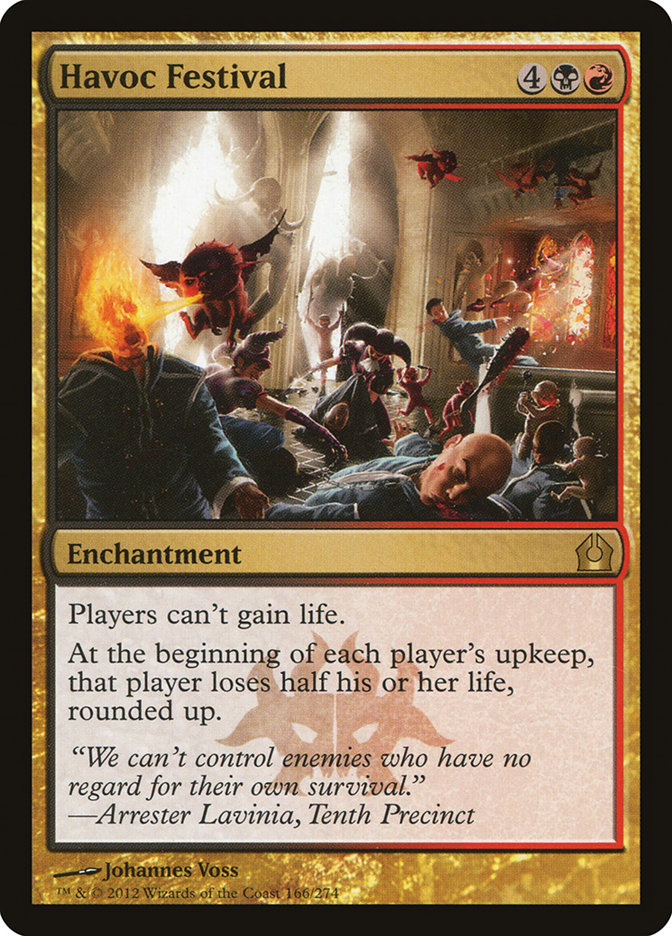
Havoc Festival is great for anyone trying to speedrun Commander. It has inevitability written all over it (literally), and it leaves its mark even when it doesn’t deal the finishing blow.
#35. Harsh Mentor
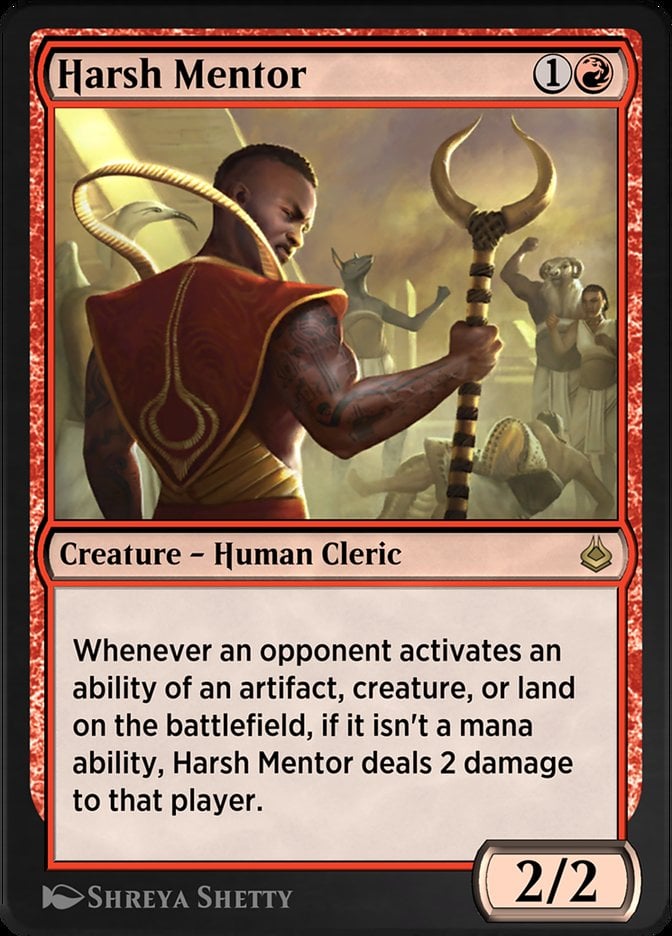
We all have memories of a strict teacher from grade school. A Harsh Mentor, if you will. This one keeps a close eye on activated abilities. It excludes mana abilities and loyalty abilities, but it lines up well against infinite combos involving activated abilities. Think Kiki-Jiki, Mirror Breaker or Staff of Domination.
#34. Burning Earth
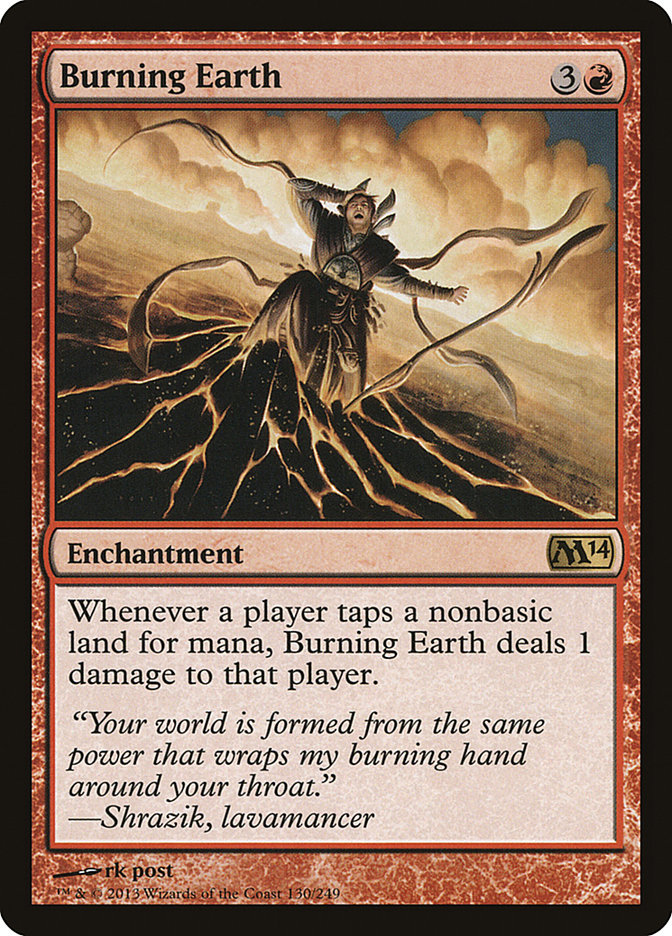
Burning Earth is the “less mean” version of Manabarbs, pinging players for tapping non-basic lands. It doles out less damage, but you can break parity by running more basics. I suppose there’s nothing stopping you from running both enchantments side-by-side.
#33. Manabarbs

Casting spells with Manabarbs in play is pure misery. Whatever your life total is when it hits the battlefield, that’s how many more lands you get to tap for mana. The chokehold is even worse if it sticks at a point when life totals are already low.
#32. Hydra Omnivore
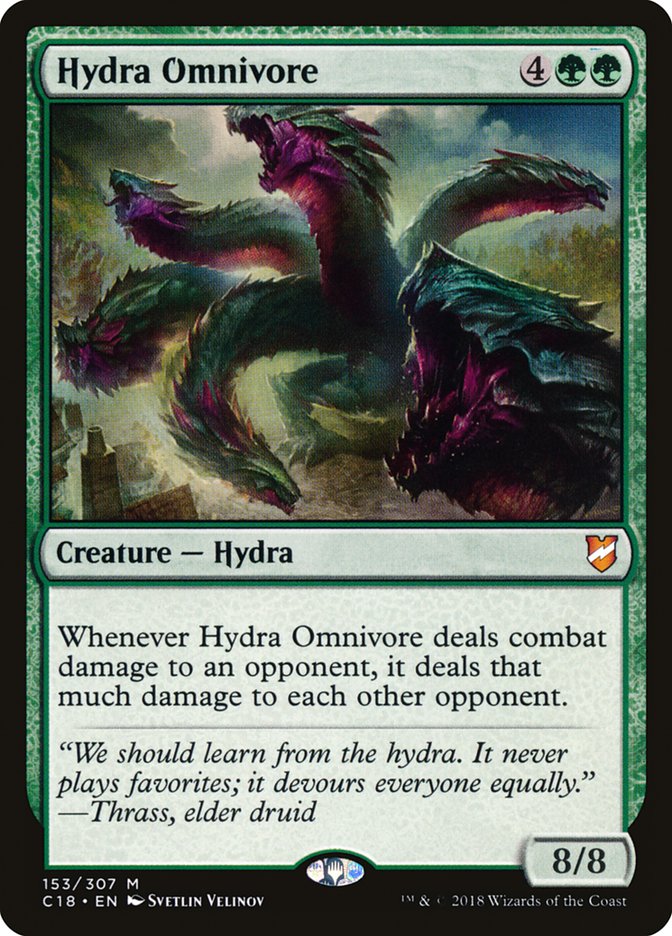
Nothing irritates me more than taking damage because one of my opponents didn’t block Hydra Omnivore. Do something my friend, we’re in this together!
#31. Stormfist Crusader
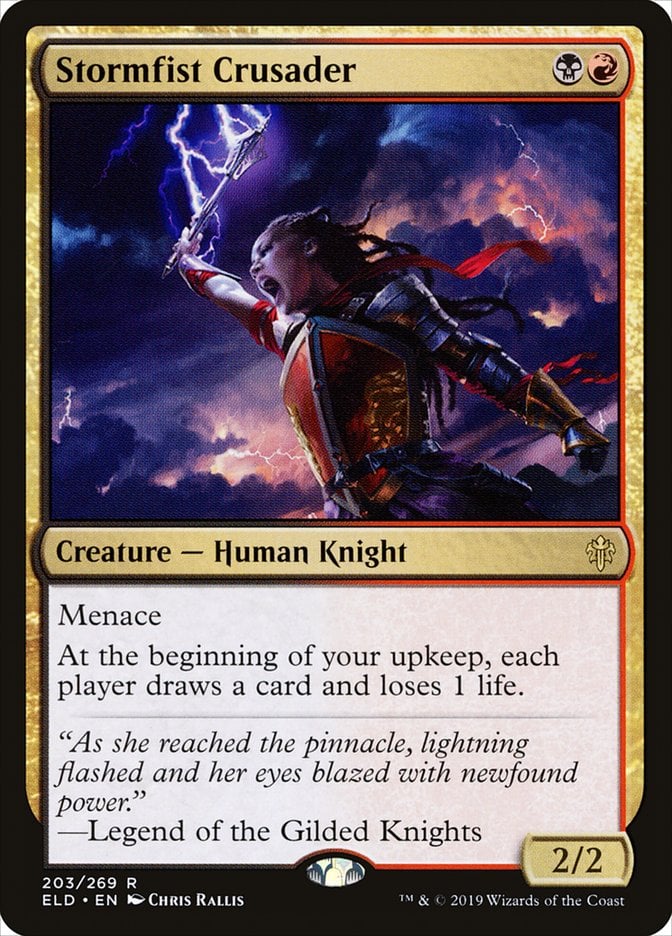
Short, simple, to the point. Playing Stormfist Crusader is like giving everyone at the table a Phyrexian Arena. Everyone gets something, but at a cost.
#30. Fevered Visions

Fevered Visions is the very essence of group slug. Everyone’s getting a benefit, but I’m coming out on top. As far as Howling Mine effects go, Visions is one of the best.
#29. Sulfuric Vortex
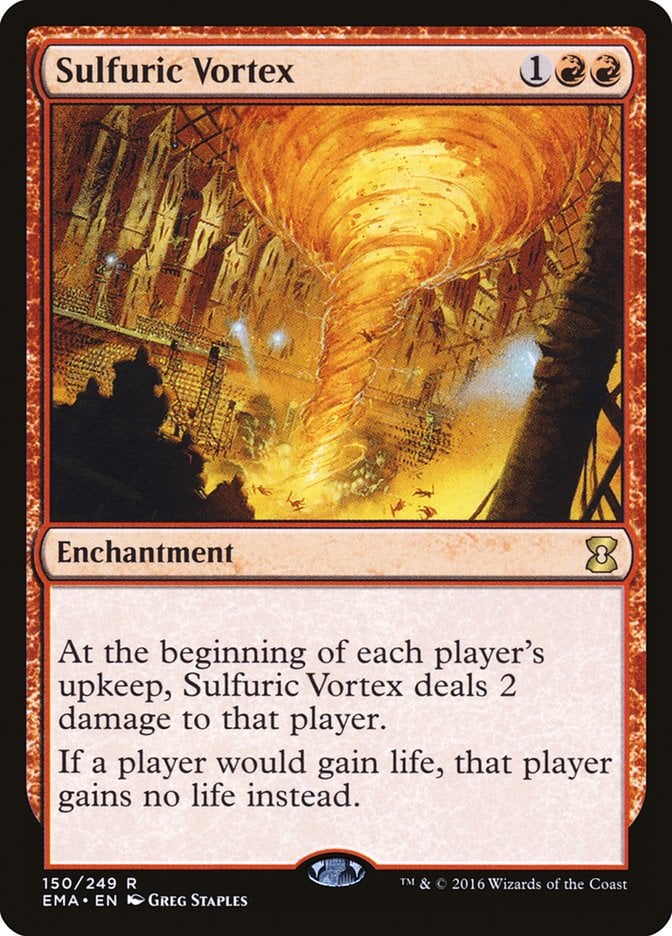
One way to combat group slug decks is with lifegain. One way to combat lifegain is with Sulfuric Vortex. Sorry friends, life totals only go down here.
#28. Court of Ambition
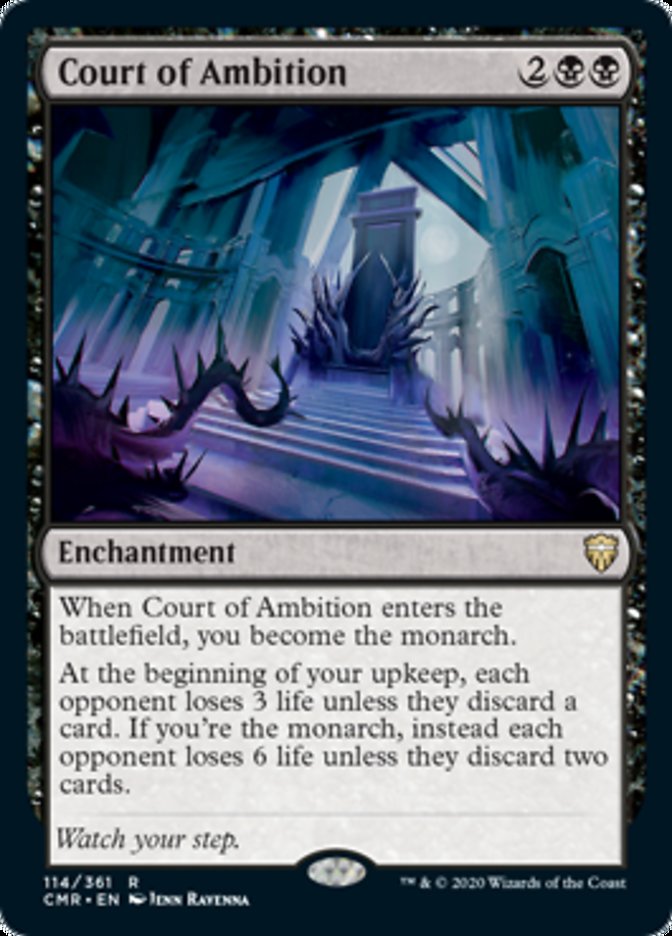
Quiet please, Court of Ambition is now in session. It’s a softer Painful Quandary since the discard/lose life dilemma happens only once per turn cycle. It does introduce The Monarch, which is another layer of complexity in games where life totals are plummeting.
#27. Kaervek the Merciless
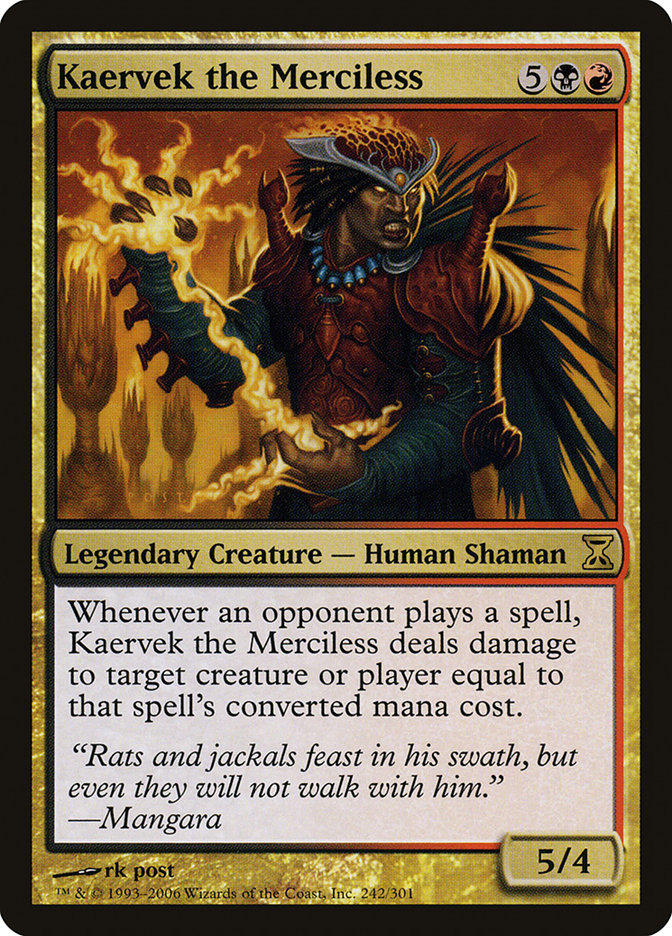
Seven mana’s tough, but Kaervek the Merciless compensates in an extremely spiteful way. You’d better hope the first spell you cast into Kaervek is a removal that kills a 5/4 or you’re in trouble.
#26. Nekusar, the Mindrazer
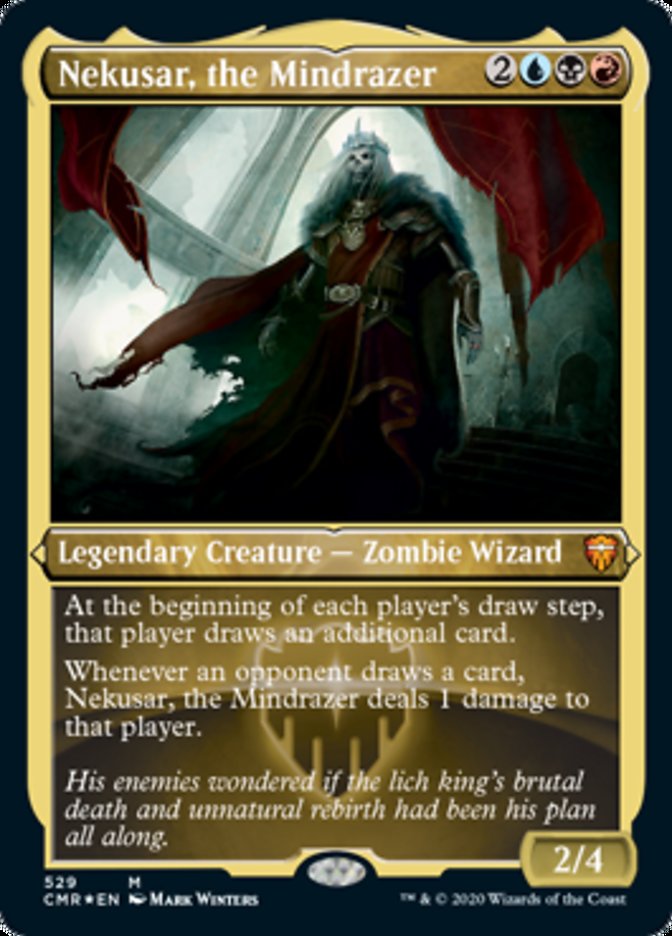
I’ve previously called Nekusar, the Mindrazer an early boogeyman of EDH. That title doesn’t hold up, but that doesn’t stop Nekusar from being a big ol’ meanie anyway. As with Spiteful Visions, it acts like it’s being generous, but has only malicious intent.
#25. Roiling Vortex

Roiling Vortex is a modern-day spin on Sulfuric Vortex. It doesn’t add up damage as quickly, and the lifegain prevention isn’t a blanket static effect. Still, that middle ability punishes free spells and comes up more often than you’d expect, and it hurts when it does.
#24. Zo-Zu the Punisher + Ankh of Mishra
Zo-Zu the Punisher and Ankh of Mishra are two aesthetically different cards with the same rules text. Ankh comes down earlier and dodges creature removal. Zo-Zu can be your commander and benefits from damage amplifiers like Torbran, Thane of Red Fell. Pish-posh about which one’s better; if you want one, you certainly want the other.
#23. Cemetery Gatekeeper

Cemetery Gatekeeper does an interesting Zo-Zu the Punisher impression with any card type. Playing against a spellslinger deck? Exile an instant and tax them on every spell they cast. Against enchantress? Easy pickings. Someone build a cool deck looking to have fun with the new battles from MOM? Yeah, we’ll see about that.
#22. Angrath, the Flame-Chained
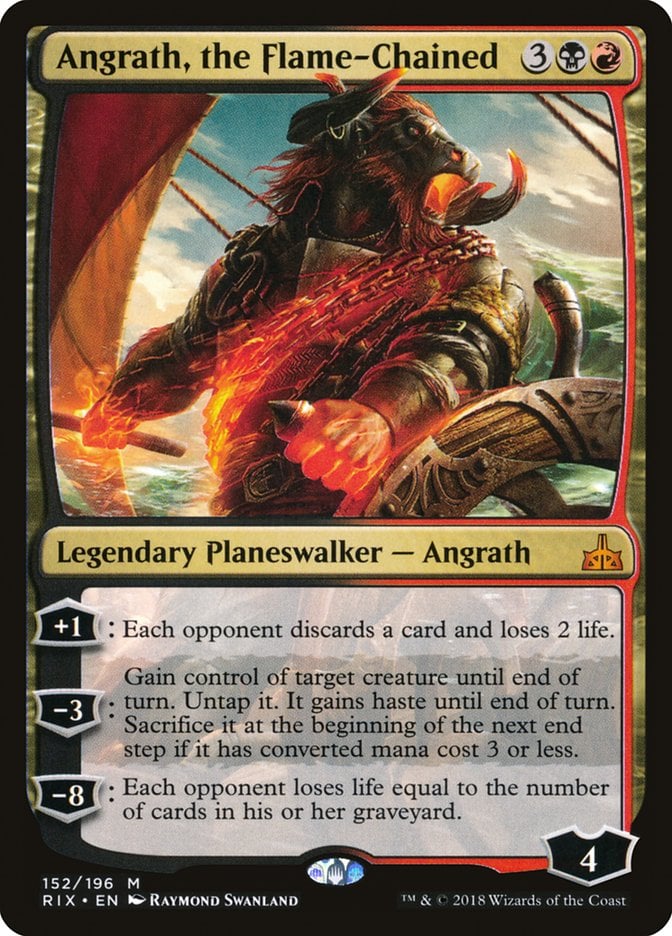
Angrath, the Flame-Chained saw print at a time when every other planeswalker was trying to mimic the 5-mana +1/-3/-8 formula from Ob Nixilis Reignited. It led to repetitive planeswalker design, but at least Angrath plays on a different axis. The +1 is the sluggy part of the card, eating away at your opponents’ hands and life totals.
#21. Mogis, God of Slaughter
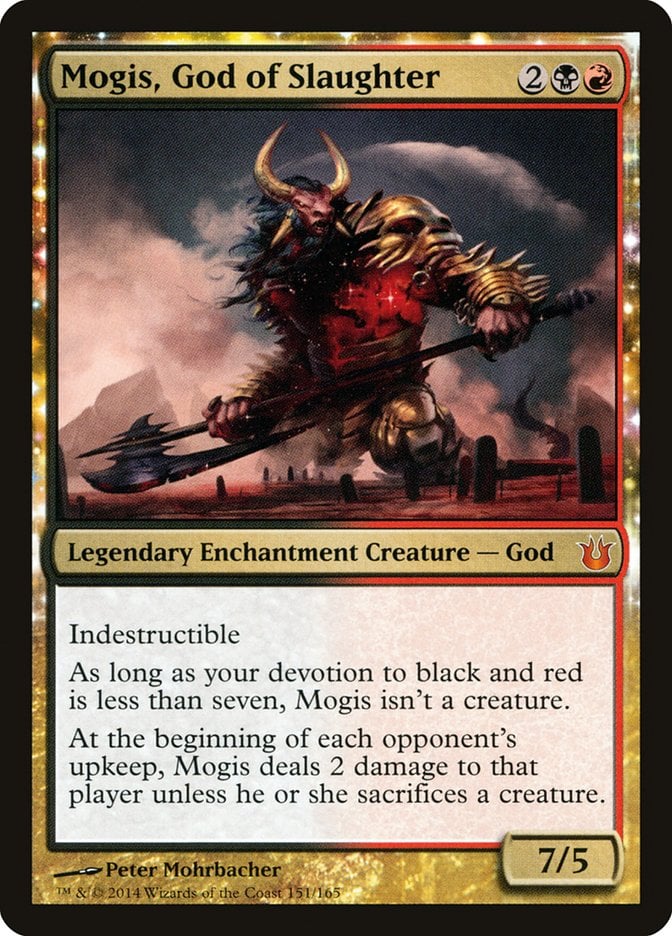
Do the denizens of Theros really worship a God of Slaughter? That seems… problematic. Mogis, God of Slaughter demands a blood sacrifice on each opponent’s upkeep. That offering can come from a creature, but they’re forced to pay life if they don’t control any.
#20. Suture Priest

Part Blood Seeker, part Soul Warden, Suture Priest works on life totals in a discreet way. “Death by 1,000 cuts” is a play style all its own, and Suture Priest is well-versed in the art of cutting.
#19. Descent into Avernus

I’ve heard countless recommendations to play Descent into Avernus, but I caution to have a plan before you put this card into play. You don’t usually want to be the one spending mana and a card for a symmetrical effect that gives everyone mana, so adjust accordingly. At the very least it accelerates games at a lightning-fast pace, so it’s bound to create some chaos.
#18. Ruric Thar, the Unbowed

Here’s one for those of you who are fed up with spellslinger decks. Ruric Thar, the Unbowed absolutely chunks anyone foolish enough to cast a non-creature spell (including you, but that’s the Gruul way). Like Kaervek the Merciless, Ruric Thar either gets answered right away or lives until the game is over.
#17. Painful Quandary
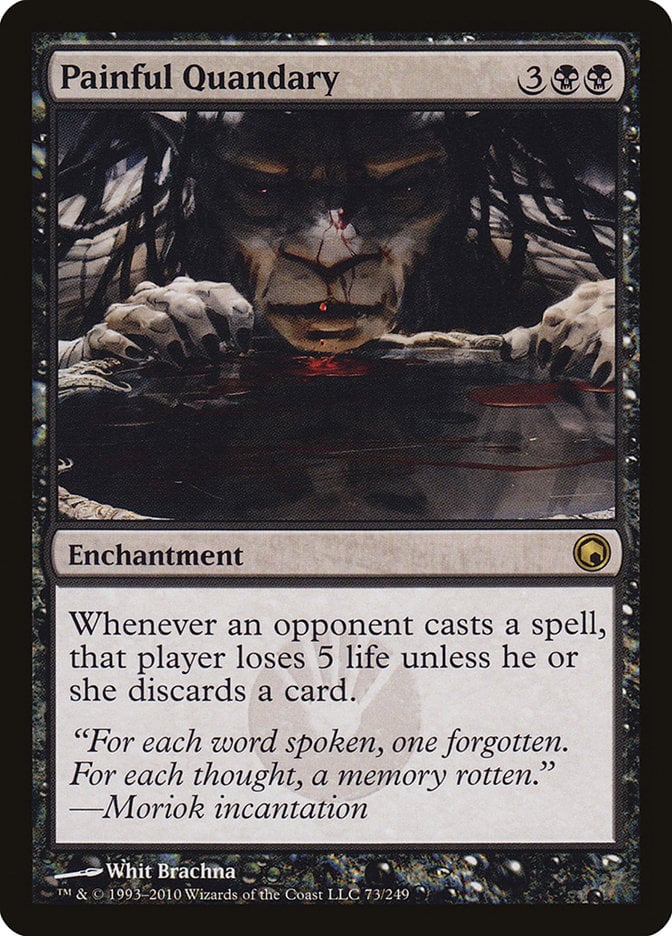
It’s a Painful Quandary indeed, but the question is simple: discard a card or lose five life? This enchantment saps your opponents of resources one way or another, which adds up during a prolonged game.
#16. Heartless Hidetsugu

People playing Heartless Hidetsugu have one thing in mind. They want to use a damage doubler like Dictate of the Twin Gods to OTK anyone with an even life total. Odd life totals survive at one. You’ve been warned.
#15. Chandra, Torch of Defiance
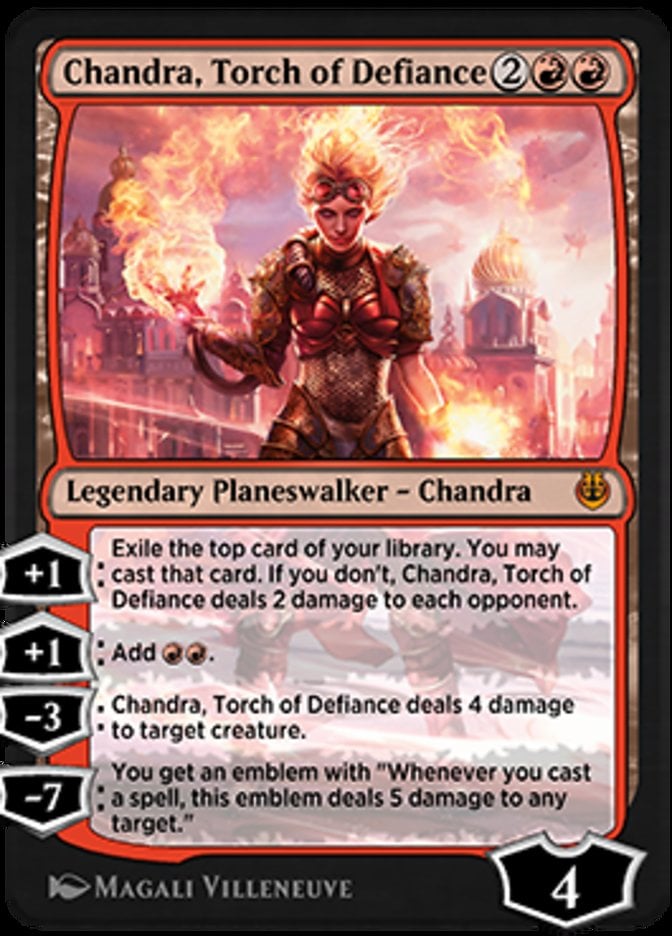
Chandra, Torch of Defiance distributes damage with its first +1 ability. You’ll want to play the impulse card more often than not, so the damage isn’t guaranteed. It’s not a traditional group slug card, but it’s in the ballpark.
#14. Yurlok of Scorch Thrash
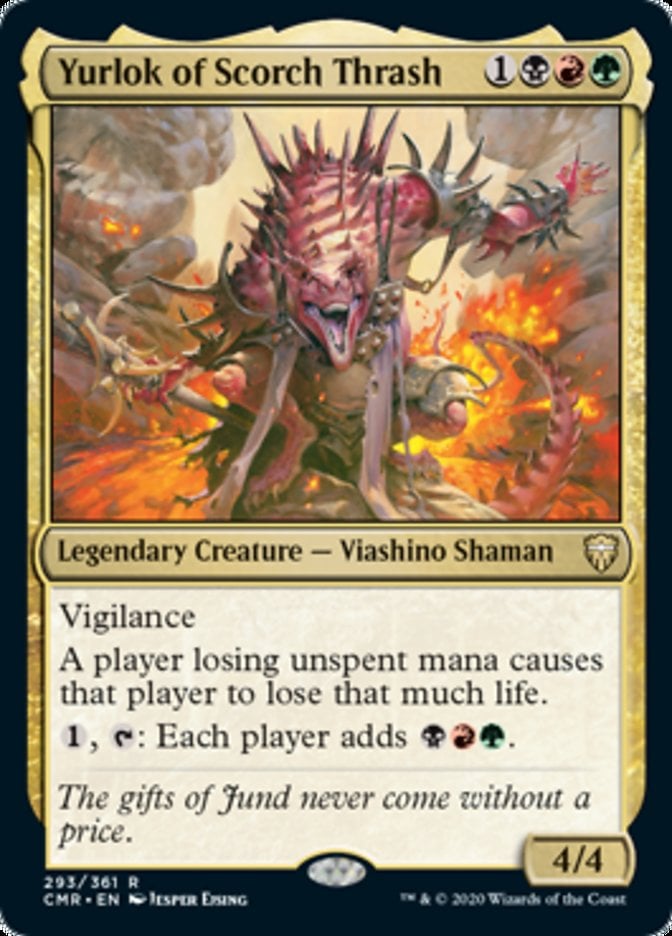
For those of you pining for the days of old when mana burn existed, this one’s for you. Yurlok of Scorch Thrash gives everyone mana, then burns them if they can’t sink it somewhere. It’s a dangerous game, but the flavor text says it all.
#13. Professor Onyx
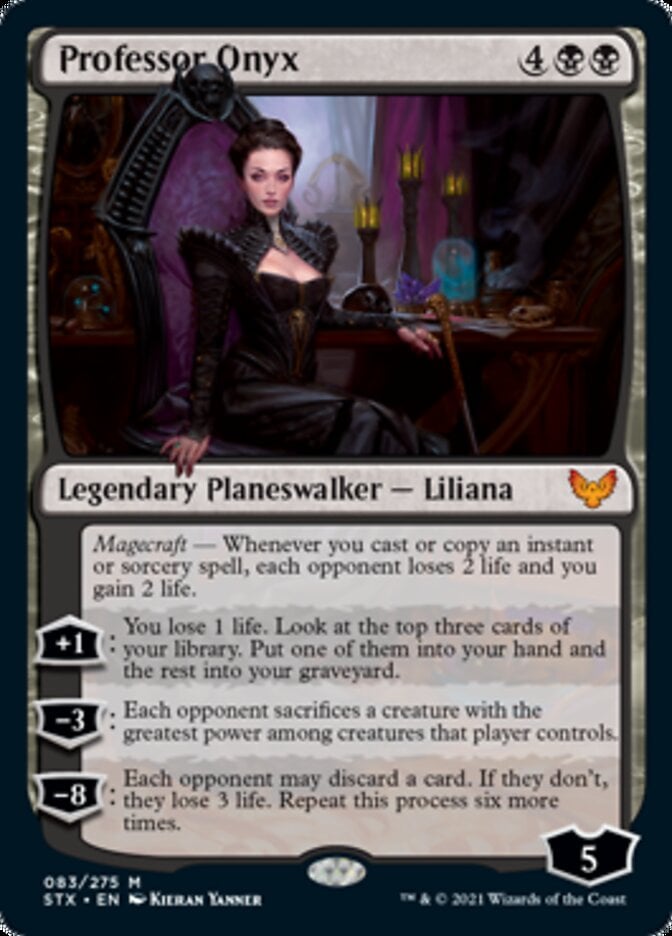
Anyone ever notice Professor Onyx looks a lot like that Liliana person? Onyx has a passive ability that’s been likened to Tendrils of Agony, draining opponents out whenever you cast a spell. It’s magecraft actually, so it includes copying spells, which happens quite often.
#12. Cindervines

Cindervines punishes non-creature spells without completely shutting them down and becomes a one-time Destructive Revelry when needed. It’s flexible and adds up meaningful damage when dropped early.
#11. Rampaging Ferodicon
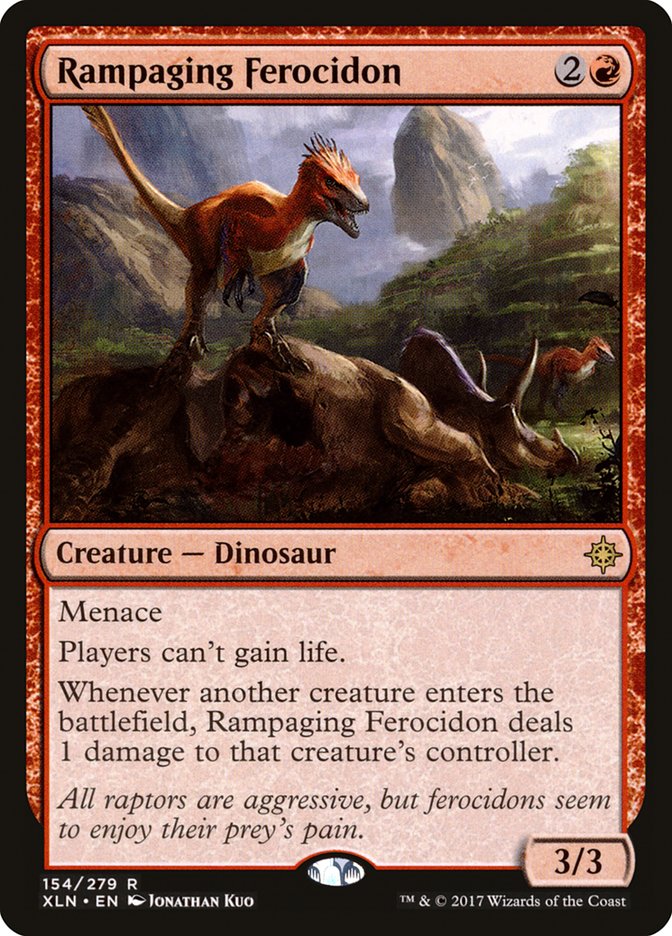
Rampaging Ferocidon stifles life totals and punishes token-making. These dinos earned themselves a spot on the Standard banlist in a meta where Goblin Chainwhirler was allowed to roam free. You can rectify that injustice by running Ferocidon in Commander, where it’s free to do exactly what it was meant to do.
#10. Liesa, Shroud of Dusk
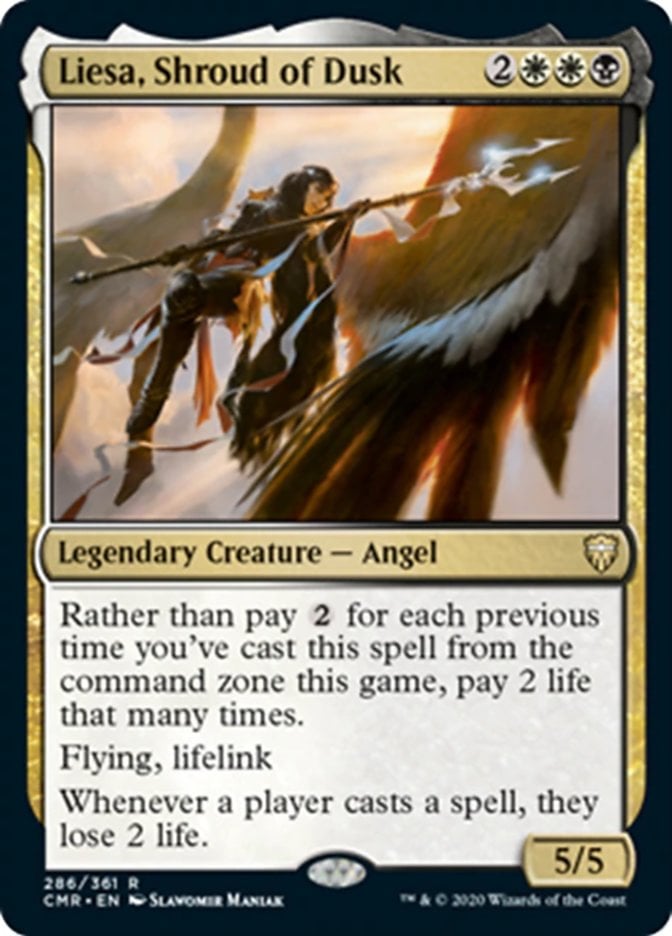
Liesa, Shroud of Dusk puts the effect of Spellshock on a large lifelinking angel. A 5/5 flier puts substantial pressure on opponents who are already losing life with every spell they cast.
#9. Chandra, Awakened Inferno
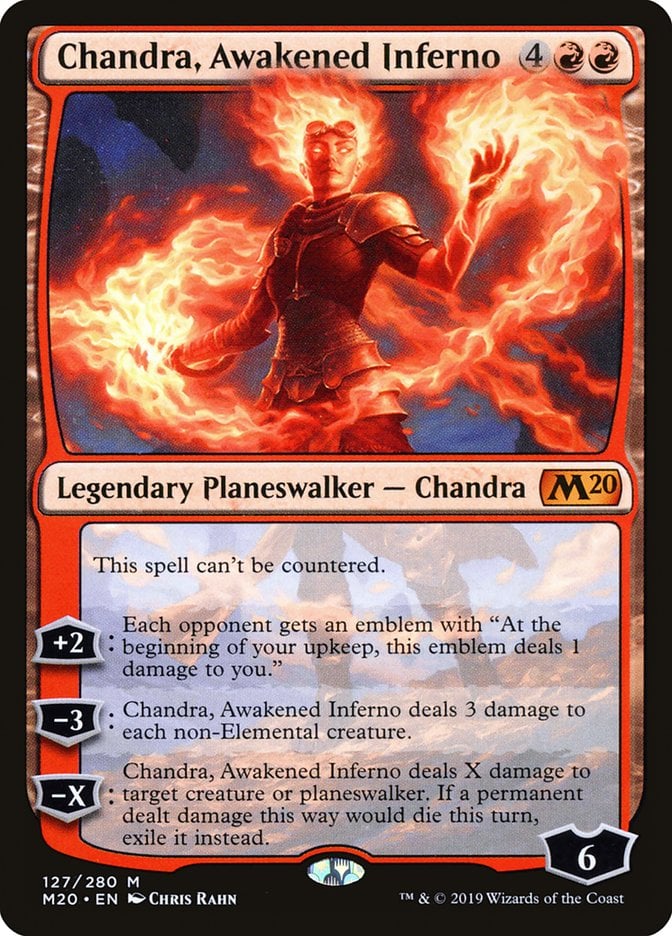
The emblems from Chandra, Awakened Inferno serve as persistent reminders that you’re going to die, but it’s going to happen slowly. Or rapidly, if you keep getting them. Chandra has some other relevant modes and can’t be countered, but the emblems are the selling point.
#8. Rankle, Master of Pranks
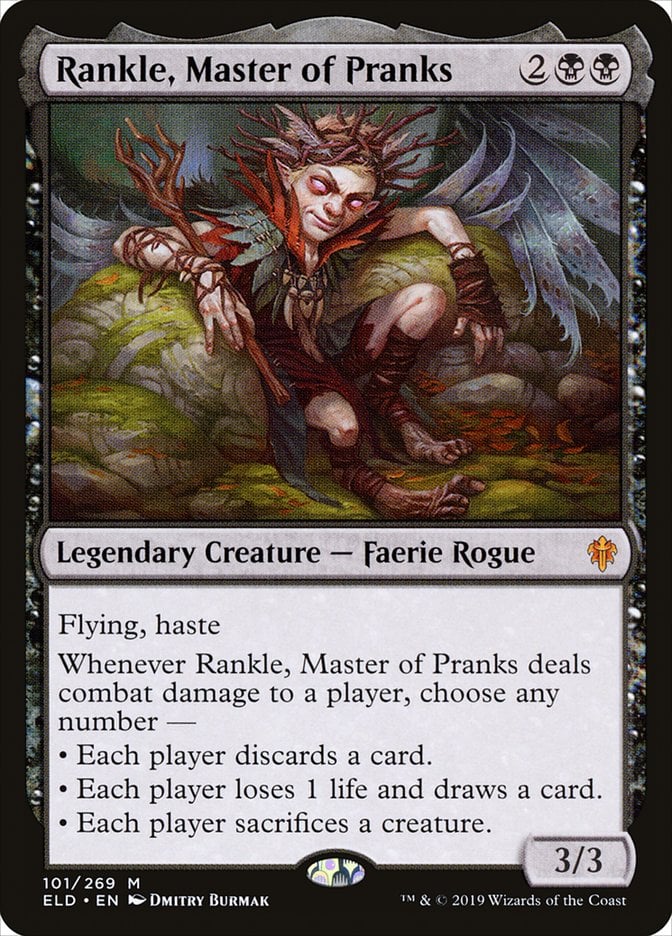
Rankle, Master of Pranks has tricks to play, so long as it can connect in combat. You have control over what happens, with a trio of group slugging abilities to choose from. That pesky Rankle and their bag of prankles.
#7. Pyrohemia + Pestilence
Pestilence and its Planar Chaos twin Pyrohemia can split up damage across different turns and deal damage in increments of one, which matters for damage amplifiers and effects like Ob Nixilis, Captive Kingpin and Ghyrson Starn, Kelermorph. They can be quite oppressive if you can keep at least one survivor on board.
#6. Braids, Arisen Nightmare

Braids, Cabal Minion is banned in EDH, so the second coming of Braids had to deliver. Braids, Arisen Nightmare certainly does, delivering nothing but pain and suffering for your opponents. The key is sacrificing card types your opponents don’t control, giving them no choice in the matter and putting you ahead on cards.
#5. Warlock Class

If you’re not already playing Warlock Class in your decks, you should be. It deals passive damage on Level 1, replaces itself with card selection on Level 2, and ends your opponents’ existence on Level 3. Is that an overstatement? Play the card and find out.
#4. Kardur, Doomscourge
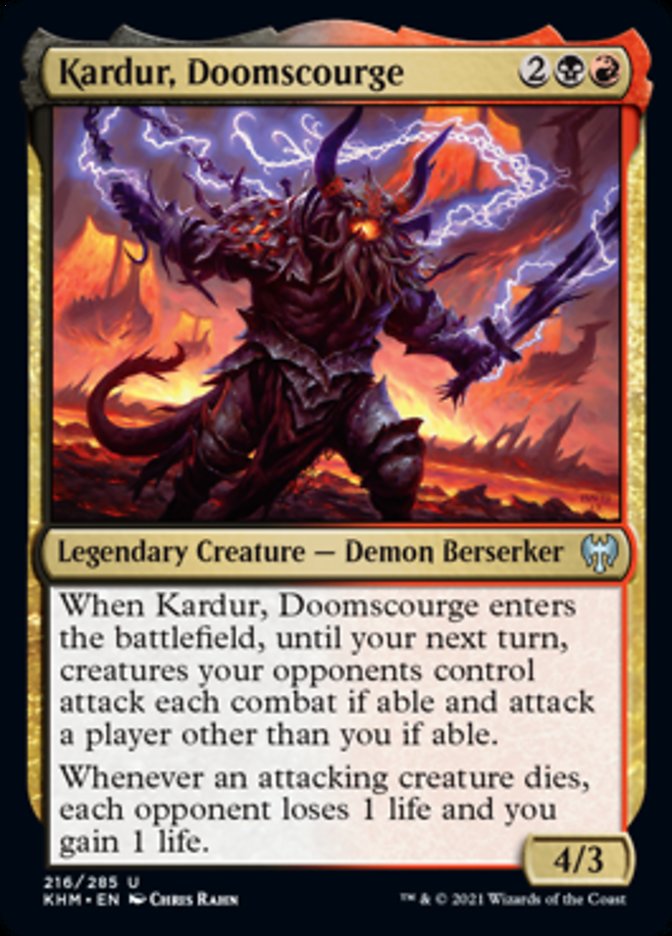
Kardur, Doomscourge is the ultimate instigator. Points fingers and makes everyone attack each other, then drains them when their attacking creatures die. It’s diabolical, really.
#3. Shadow in the Warp
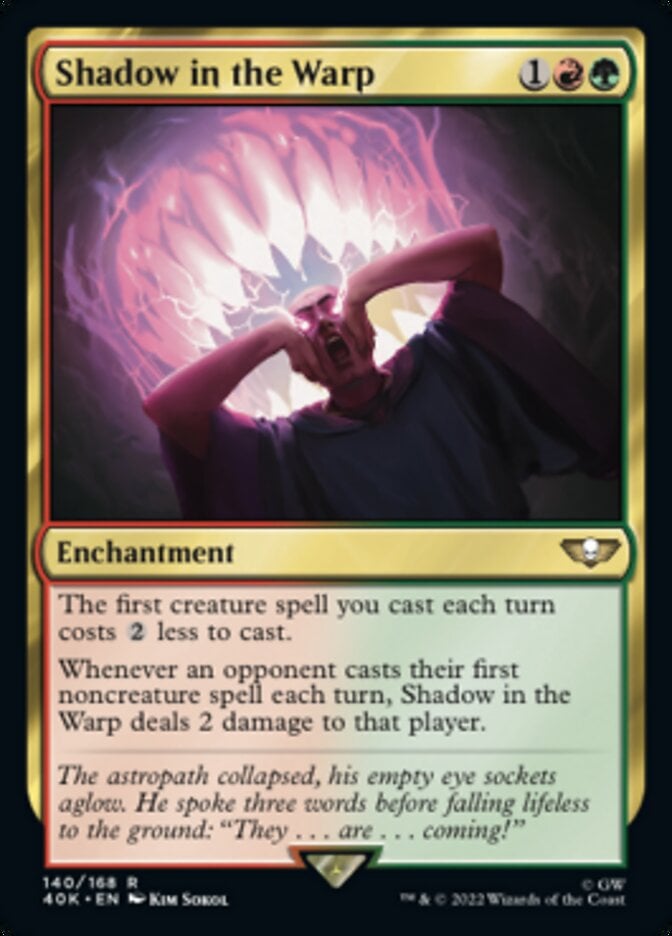
I like to joke that Shadow in the Warp is just Sol Ring and Sulfuric Vortex combined in one card. I’m not even sure how much of a joke that is, since Shadow is sometimes even better than that. It’s all upside for you, working on opponents’ life totals and making your creatures easier to cast.
#2. Sheoldred, the Apocalypse

Sheoldred, the Apocalypse is utterly terrifying, and that goes for any format. “The Apocalypse” is a well-deserved title when your typical draw-7s like Echo of Eons are dealing 14 damage to each opponent and gaining you 14 life.
#1. Klothys, God of Destiny
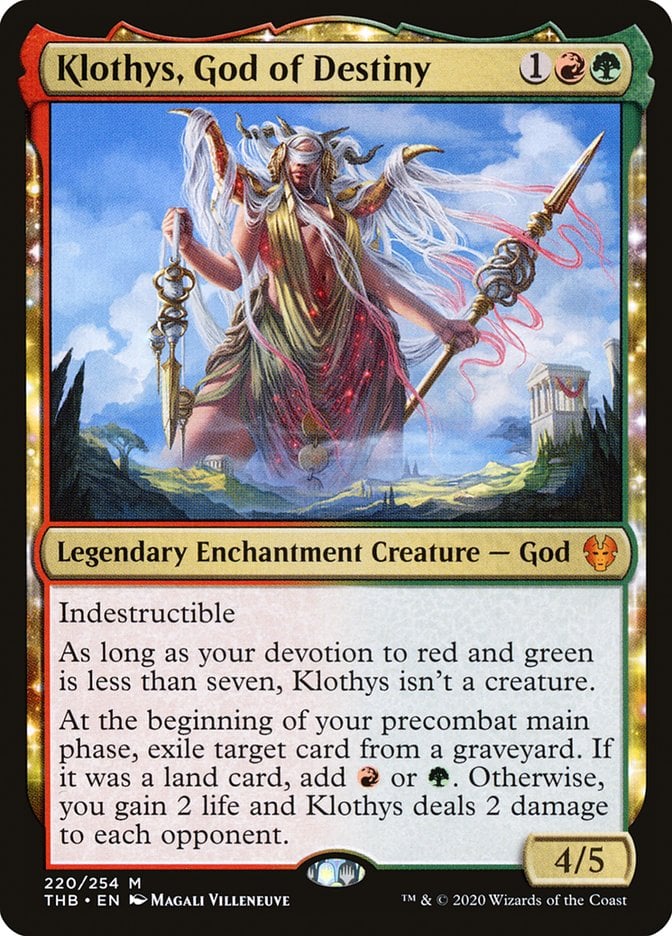
Wow these Theros gods are rude. The laundry list of things that Klothys, God of Destiny does includes damaging opponents every turn, gaining life, ramping, eating graveyards, and occasionally being an indestructible 4/5. Help us all if this is what destiny looks like.
Best Group Slug Payoffs
The main reason to play a group slug-style deck is because this type of strategy inherently lends itself to closing out games. Your cards are reducing your opponents’ life totals, after all. That’s how we tend to win Magic.
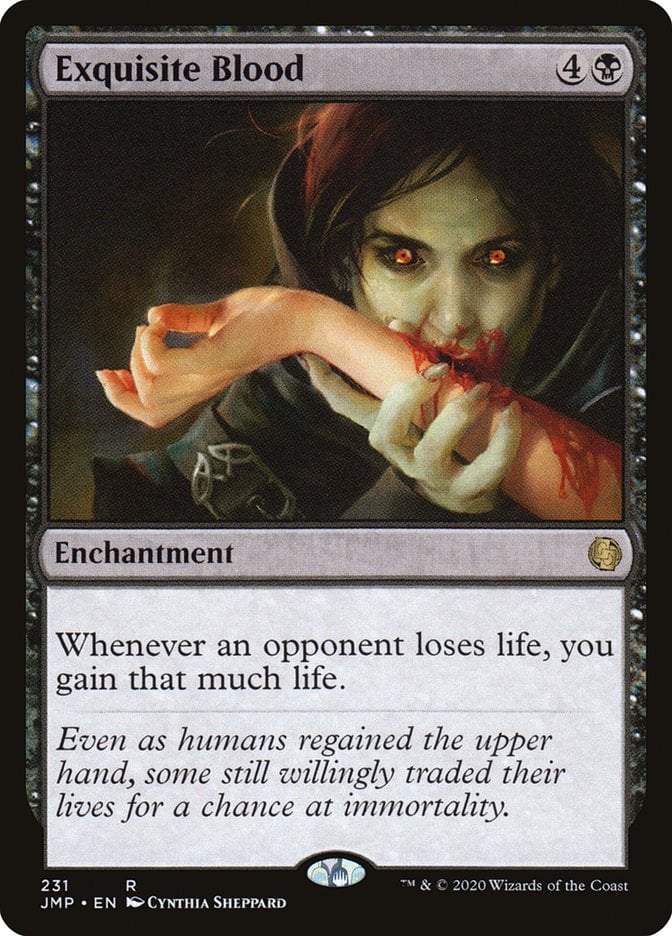
There are specific cards that tie in with consistent sources of life loss. Exquisite Blood is the best example, giving you a life total buffer that helps break parity on most of the universal damage-dealing effects. These decks are also good at easily enabling spectacle or bloodthirst abilities.
Dealing damage to yourself is also a specific gameplan for some decks. Auntie Blyte, Bad Influence and Darien, King of Kjeldor are creatures that thrive off damaging yourself. Group slug effects can trigger these cards while damaging your opponents. You can also use a group slug shell to get people in range of alternate win-cons like Triskaidekaphobia or Hidetsugu's Second Rite.
What’s the Difference Between Stax and Group Slug?
Stax effects prohibit players from taking certain actions or restrict their ability to do things, whereas group slug effects typically punish them for doing it. In other words, the stax player says “no” while the group slug player says, “go ahead, but it’s gonna hurt”.
Gaddock Teeg is an example of a stax piece. It prevents certain spells from being cast, but it doesn’t actually mess with anyone’s resources, permanents, or life totals. There’s some overlap though. You might consider Harsh Mentor a stax piece, since it puts an artificial limitation on how many times a certain action can be taken.
What’s the Opposite of Group Slug?
“Group hug” is the antithesis of “group slug.” The sluggers want to hurt people, the huggers want to help. Group hug cards generally benefit everyone, either by drawing cards, gaining life, providing mana, etc. Popular group hug commanders include Kynaios and Tiro of Meletis, Kwain, Itinerant Meddler, and Phelddagrif.
What Are Other Names for Group Slug Decks and Cards?
You might hear group slug decks being referred to as “punisher” decks or “suicide” decks. The punisher versions overwhelm opponents with damage-dealing effects that key off normal gameplay actions. They still get to play their game, but they get “punished” for doing so. I’m not fond of using the term “suicide” to describe a Magic deck, but it’s often used to refer to decks that damage to themselves while progressing their game plan. Sulfuric Vortex is a classic card in this category since you and your opponents take damage at the same rate.
As mentioned, “stax” refers to a slightly different strategy that often overlaps with group slug. Because of this overlap, you might hear the words used interchangeably. Players also often refer to dedicated discard/sacrifice decks as group slug decks, though I think it’s more accurate to separate those into different categories. Tergrid, God of Fright is a popular group slug commander, even though I’d classify it as a discard/sacrifice commander.
Sharing Is Caring
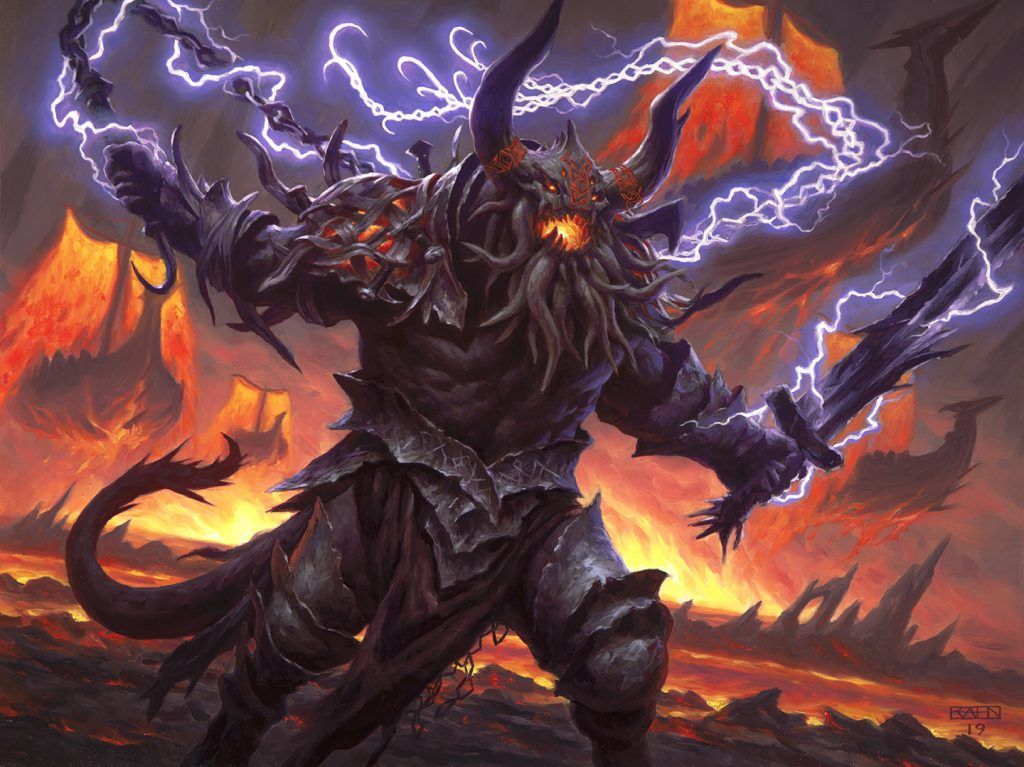
Kardur, Doomscourge | Illustration by Chris Rahn
That brings the list to a close. This should be plenty of fodder to build a group slug deck and spread the love. You might not make as many friends as you would with a group hug deck, but games need to end, don’t they?
It’s hard to nail down exactly what does and doesn’t count as a group slug card. There are plenty of cards that technically fit the criteria I presented but don’t feel like group slug cards. Does Impact Tremors count? How about Smallpox, or Vial Smasher the Fierce? Let me know how you’d classify group slug cards and any I might have missed in the comments below or over in the Draftsim Discord.
Thank you for making Draftsim your #1 stop for all things Magic!
Follow Draftsim for awesome articles and set updates: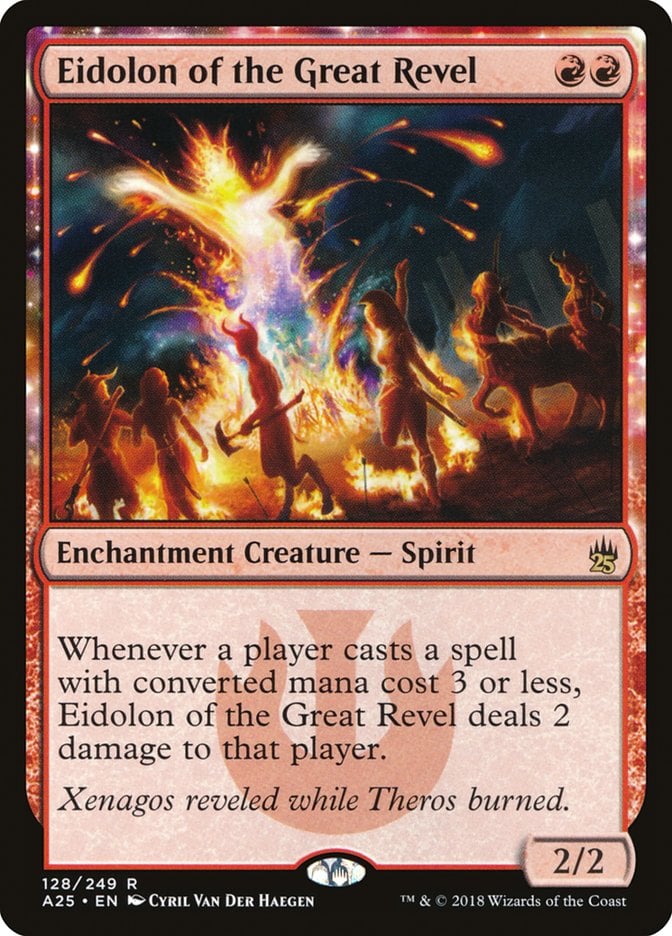
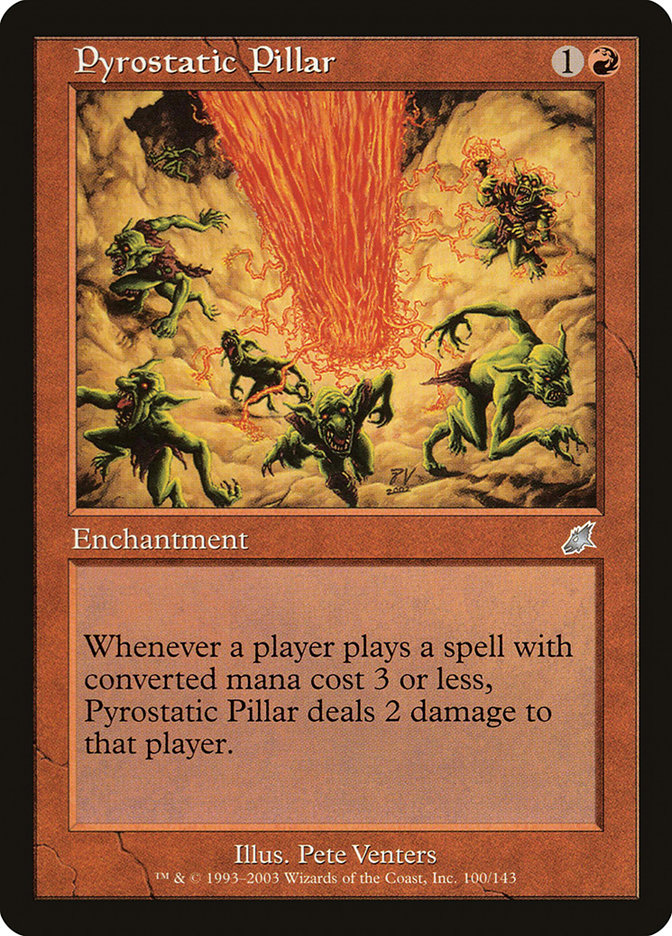
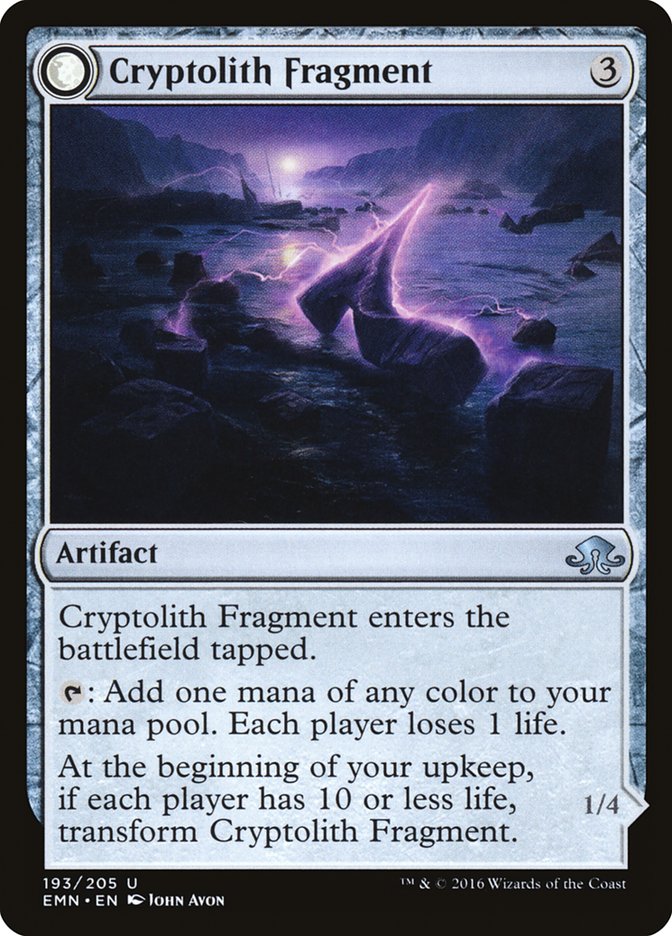

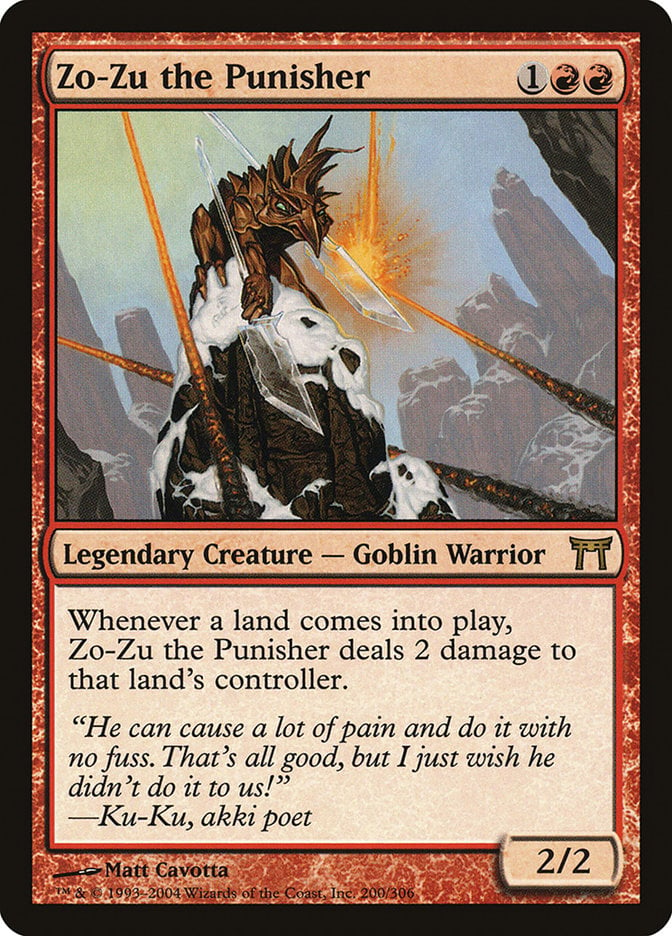
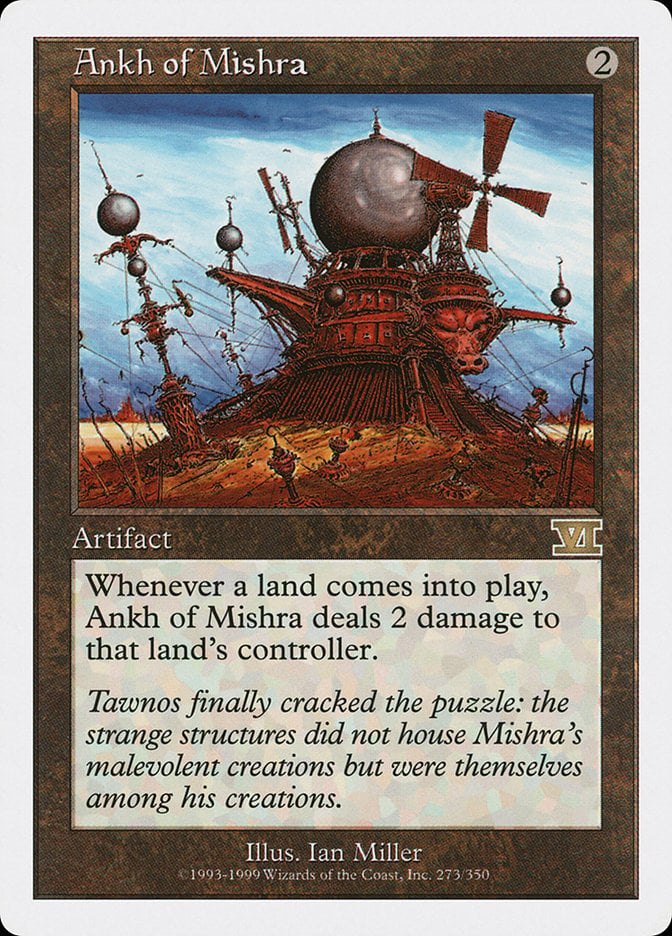

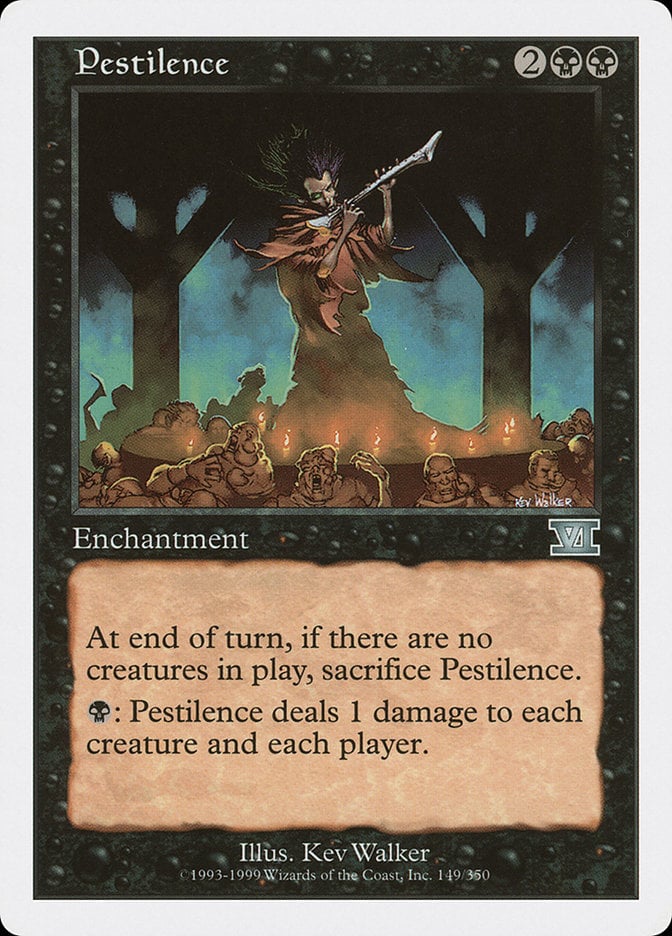
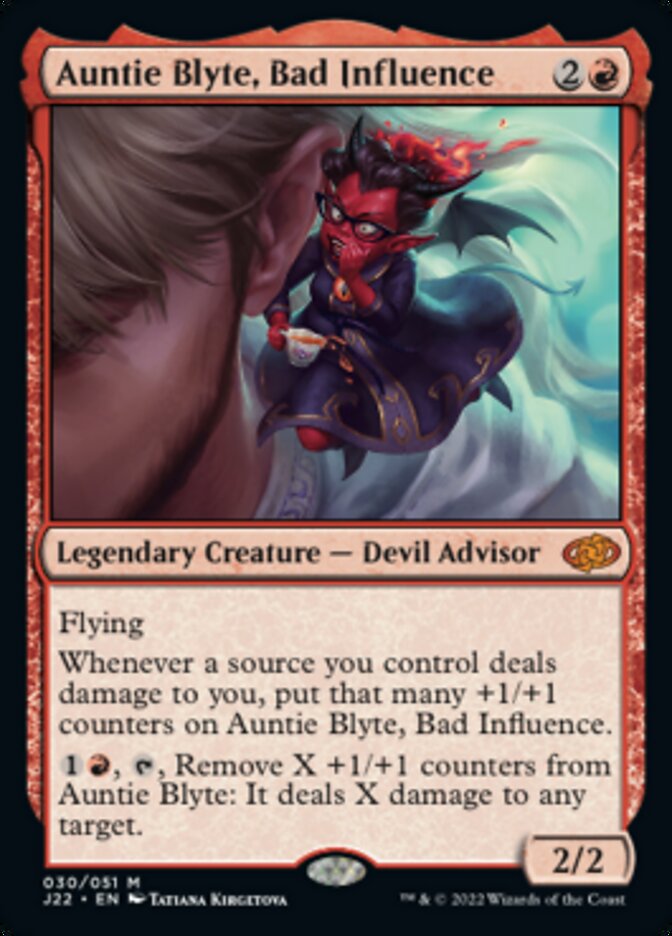
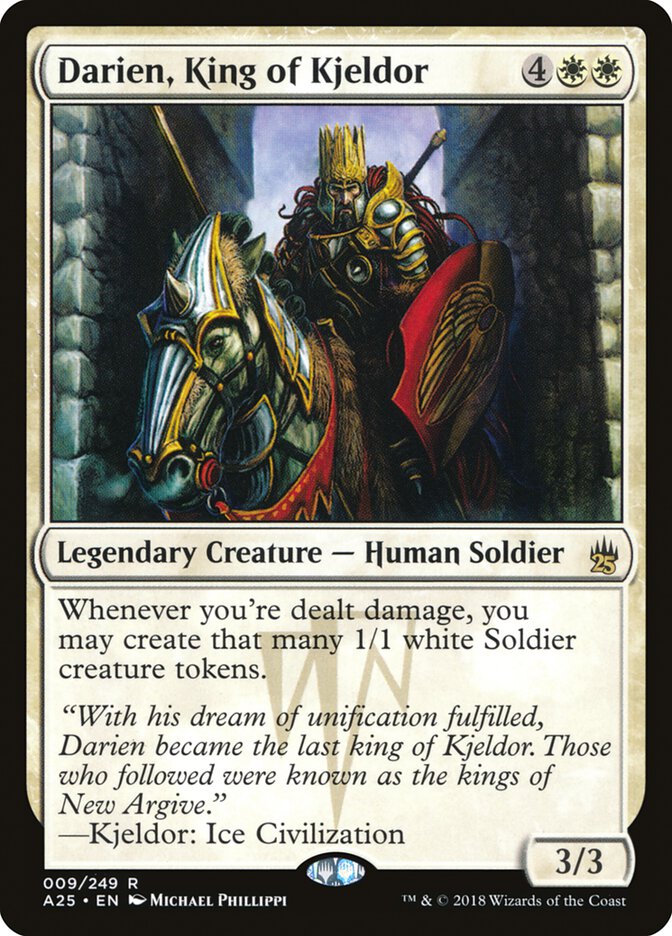


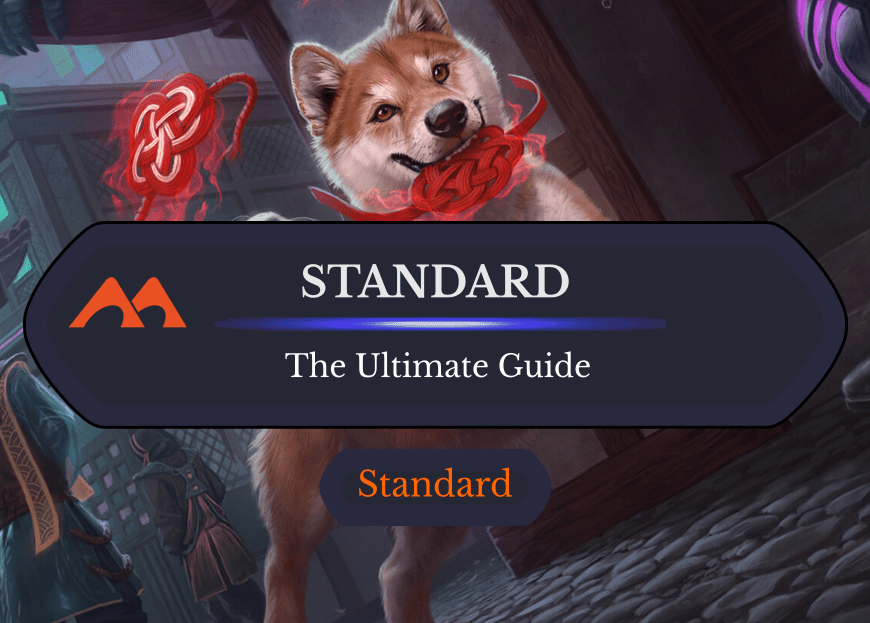

Add Comment